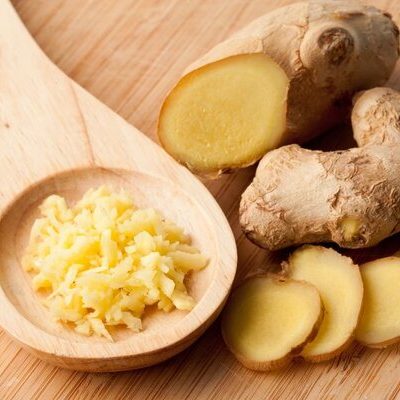
Ginger
What is Ginger?
Ginger is the root of the Zingiber officinale (believed to have derived from the Sanskrit singabera) plant. Native to India, it is commonly used as a spice and can be consumed raw or cooked.
- This root has a unique taste that can be both hot and biting with sweet tones. It is usually some shade of yellow in color and has a knobby appearance.
- It is extensively used in seasoning different dishes, as a folk medicine, and for giving a zing to baked goods, confectionery, curries, teas, beer, ale, and sweets.
There are more than a thousand species, but the most common types of ginger root are:
- Common
- Beehive
- Bitter
- Myoga
- Crepe
- Hidden
Origin of ginger
Both this root and its scientific name, Zingiber officinale, is believed to have come from the Sanskrit singabera, which means ‘shaped like a horn’. The use of ginger goes back several millennia and was originally cultivated in India. There is evidence that it was being used as a medicine as well as a spice under Ayurveda and Chinese Traditional Medicine. Ayurvedic texts describe it as a remedy for digestive issues and pain. Confucius also wrote about it positively and talked about its role in digestion.
This was one of the first spices to have travelled to Europe from Asia, around the first century, though it was very expensive. Ancient Romans used ginger extensively but its use fell after the fall of the Roman empire. Today, it is one of the most commonly traded spices around the world.
Commercial production
It is sold in several different forms, such as raw, dried, pickled, powdered, preserved, crystallized, and ginger oil. This root requires a warm and humid climate to grow well. It grows best in well-drained and fertile sandy or loamy soils. The harvesting takes at least six months. Once harvested, it is either sold raw and fresh, or goes on for further processing.
India is the largest producer around the world, followed by China, Nigeria, Nepal, Indonesia, Thailand, Bangladesh, Cameroon, Japan, the Philippines, Mali, and Taiwan. The main consumers are India, Indonesia, Nepal, Nigeria, and China. The overall market was around 3.3 million tons in 2018.
Nutrition
It is rich in B vitamins such as B2, B3, B6, & B9, vitamin C, iron, potassium, magnesium, phosphorus, and zinc. One tablespoon contains:

It is also a good source of fiber and protein. According to some research, ginger has been proved to contain properties that ease nausea and vomiting and improve gastrointestinal function. It also eases pain and possesses anti-inflammatory and antioxidant properties. In addition, it may also protect against colorectal cancer and heart diseases.
However, overconsumption may cause diarrhea and indigestion. Also, menstrual bleeding may increase in women. If you have adverse effects to this root, stop consuming it immediately.
Ginger recipes
This root is a very versatile spice and can be used to flavor a variety of dishes. It can be used in soups, smoothies, vegetables, and salads to give an extra zing. It is often used as marinades for meat dishes. It is also a valuable addition to certain cocktails. Here are a few ginger-based recipes.
- Spiced Chicken
- Homemade Juice
- Pickled ginger
- Fried Rice
- Chai with Milk
- Inji Kichadi
- Inji Thogayal
- Jollof Rice
- Black Beans Stew
- Plantain Pancakes with Lemon Honey Syrup
- Veggie Stir Fry
FDA regulations
This root is classified as a spice by the FDA and is a natural seasoning. It is recognized as safe for their intended use. Ginger extract is also regulated by the FDA. It is also classified as a rarely consumed raw produce.
References
Simi Jois, 5 Things You Didn’t Know About: Ginger, Tasty Bite, http://tastybite.com/2016/05/5-things-you-didnt-know-about-ginger/
Crop Cultivation Guide: Ginger (SPICES & CONDIMENTS), IndiaAgroNet.com, https://www.indiaagronet.com/horticulture/CONTENTS/ginger.htm
Bode AM, Dong Z. The Amazing and Mighty Ginger. In: Benzie IFF, Wachtel-Galor S, editors. Herbal Medicine: Biomolecular and Clinical Aspects. 2nd edition. Boca Raton (FL): CRC Press/Taylor & Francis; 2011. Chapter 7, https://www.ncbi.nlm.nih.gov/books/NBK92775/
Khodaie, Laleh, and Omid Sadeghpoor. “Ginger from ancient times to the new outlook.” Jundishapur journal of natural pharmaceutical products vol. 10,1 e18402. 17 Jan. 2015, doi:10.17795/jjnpp-18402, https://www.ncbi.nlm.nih.gov/pmc/articles/PMC4377061/
Anh, Nguyen Hoang et al. “Ginger on Human Health: A Comprehensive Systematic Review of 109 Randomized Controlled Trials.” Nutrients vol. 12,1 157. 6 Jan. 2020, doi:10.3390/nu12010157
https://www.ncbi.nlm.nih.gov/pmc/articles/PMC7019938/
